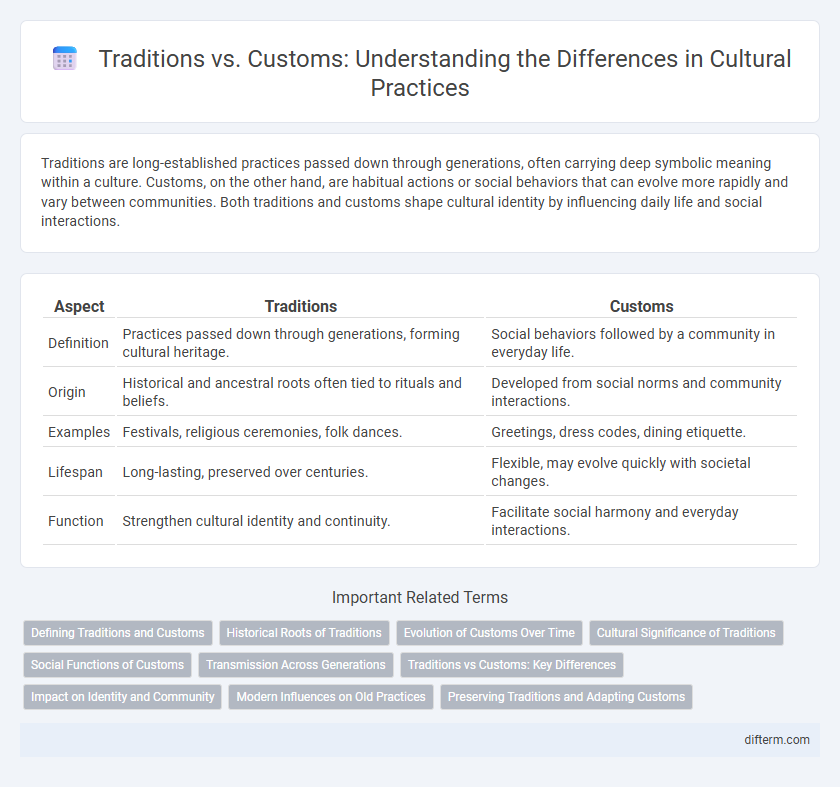Traditions are long-established practices passed down through generations, often carrying deep symbolic meaning within a culture. Customs, on the other hand, are habitual actions or social behaviors that can evolve more rapidly and vary between communities. Both traditions and customs shape cultural identity by influencing daily life and social interactions.
Table of Comparison
| Aspect | Traditions | Customs |
|---|---|---|
| Definition | Practices passed down through generations, forming cultural heritage. | Social behaviors followed by a community in everyday life. |
| Origin | Historical and ancestral roots often tied to rituals and beliefs. | Developed from social norms and community interactions. |
| Examples | Festivals, religious ceremonies, folk dances. | Greetings, dress codes, dining etiquette. |
| Lifespan | Long-lasting, preserved over centuries. | Flexible, may evolve quickly with societal changes. |
| Function | Strengthen cultural identity and continuity. | Facilitate social harmony and everyday interactions. |
Defining Traditions and Customs
Traditions are long-established practices, beliefs, or rituals passed down through generations within a culture, often carrying symbolic meaning and historical significance. Customs refer to habitual actions or social behaviors practiced by a community, reflecting everyday norms and societal expectations. Both traditions and customs shape cultural identity but differ in scope, with traditions embodying deeper cultural heritage while customs influence routine social interactions.
Historical Roots of Traditions
Traditions, deeply rooted in historical events and cultural heritage, often originate from ancient rituals passed down through generations, reflecting a community's collective identity and values. Customs, while sometimes derived from traditions, tend to be more flexible practices influenced by social, economic, or environmental changes over time. Understanding the historical roots of traditions provides insight into why certain rituals persist and how they shape cultural continuity and social cohesion.
Evolution of Customs Over Time
Customs evolve gradually through generations, shaped by social, economic, and technological changes that reflect a community's adapting identity. Unlike fixed traditions, customs exhibit flexibility, allowing integration of new practices while maintaining core cultural values. This dynamic evolution ensures cultural relevance and resilience in an ever-changing global landscape.
Cultural Significance of Traditions
Traditions hold deep cultural significance as they embody the collective values, beliefs, and history passed down through generations, strengthening community identity and continuity. Unlike customs, which are often individual practices or routines, traditions serve as symbolic acts that reinforce societal norms and shared heritage. They play a crucial role in preserving cultural cohesion, fostering a sense of belonging, and transmitting cultural knowledge within societies.
Social Functions of Customs
Customs serve vital social functions by fostering community cohesion and reinforcing shared values within a group. These repetitive social behaviors, such as greeting rituals or festival celebrations, create predictability and strengthen interpersonal bonds, promoting social stability. Unlike broader traditions, customs operate on everyday levels, directly influencing social interactions and cultural continuity.
Transmission Across Generations
Traditions are deeply rooted practices passed down through generations, often formalized and carrying significant cultural meaning, while customs are habitual behaviors that may evolve more fluidly within communities. The transmission of traditions relies heavily on rituals, storytelling, and communal participation, ensuring the preservation of core cultural identities. In contrast, customs adapt quickly to social changes, reflecting the dynamic nature of cultural expression in everyday life.
Traditions vs Customs: Key Differences
Traditions are inherited, long-established practices passed down through generations, often rooted in cultural or religious significance, while customs refer to habitual behaviors or social norms specific to a community or society. Traditions tend to have a formalized structure and symbolism, whereas customs may be informal and adaptable to changing social contexts. Understanding the distinction helps highlight how traditions preserve cultural identity, while customs shape everyday social interactions.
Impact on Identity and Community
Traditions serve as long-standing practices passed down through generations that profoundly shape group identity by reinforcing shared values and historical continuity. Customs, often more flexible and localized, influence community cohesion by adapting cultural expressions to contemporary social contexts. Both elements intertwine to maintain a sense of belonging while allowing cultural evolution within societies.
Modern Influences on Old Practices
Modern influences reshape traditions and customs by introducing new values and technologies that alter their original forms and meanings. Globalization, digital media, and migration blend diverse cultural elements, creating hybrid practices that challenge the preservation of authentic heritage. Despite these changes, many communities actively adapt old customs to contemporary contexts, ensuring cultural continuity amid evolving social dynamics.
Preserving Traditions and Adapting Customs
Preserving traditions ensures the continuity of cultural heritage by maintaining rituals and values passed down through generations, safeguarding identity and collective memory. Adapting customs allows cultures to remain dynamic, incorporating contemporary influences and responding to social changes while retaining core elements. Balancing preservation and adaptation fosters cultural resilience and relevance in a rapidly evolving global society.
Traditions vs Customs Infographic

 difterm.com
difterm.com